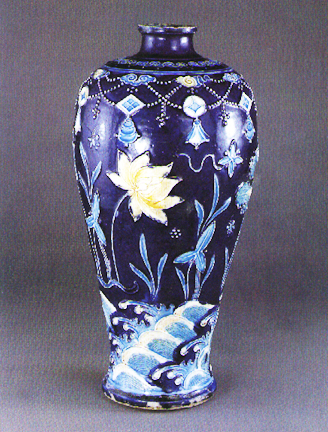
Ming Dynasty Fahua vase, Earthenware
China, 1450 CE, 16.6" height
ART 198 - HISTORY OF WORLD CERAMICS
| Ming Dynasty ceramics (1368-1644 CE) followed the more austere style of the Song with a more exuberant flowering of ceramic approaches. One of the more distinctive styles is referred to as Fahua ware, and is seen here in this example. This meiping (plum blossom vase) echoes the elegant shapes of its Song forebears, but the surface treatment could not be more different from the refined celadons seen earlier. This example, decorated with lotus flowers (usually a symbol of the Buddha) and insects above a pattern of repeated waves, is typical of Fahua ware. A problem still encountered by modern ceramic artists is that glaze colors such as this most always run together on vertical surfaces as the fluid glazes melt in the kiln, often ruining the clarity of the design. An ingenious solution to this problem is used in Fahua ware. Using a slip trailer, a line of body slip was trailed onto the surface of the leatherhard pot, drawing the design in a three dimensional, raised line. After bisque, the glazes were painted on, and the raised effect of the trailing (functioning like cloissones in metal enameling) would serve to separate the glaze colors, limiting the tendency to run. Cobalt was used for the deep blue of the glaze, and copper was the metallic oxide used for the turquoise. The white is the body color. | Ming Dynasty Fahua vase, Earthenware China, 1450 CE, 16.6" height |
|
|